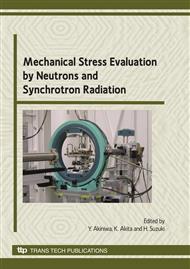p.99
p.105
p.111
p.116
p.123
p.129
p.133
p.139
p.143
Investigation of Residual Stress in Laser Formed Mild Steel Plates Using Neutron Diffraction
Abstract:
Forming of metal plates with a high-power laser beam is a flexible materials forming technique. Bending results from the establishment of a steep temperature gradient through the material thickness which leads to non-uniform thermal expansion/contraction and subsequently residual stresses. It is important to characterize these residual stresses as a function of process parameters such as line energy (LE) to optimize treatment conditions and to gain an insight into the mechanism of the formation of the final geometries. Non-destructive neutron diffraction measurements were carried out on ENGIN-X at ISIS and KOWARI at ANSTO to map the residual stress distribution around the heat affected zone (HAZ) of laser deformed mild steel plates for single and multiple passes as a function of line energy (LE), the primary laser forming process parameter. It was found that in the centre of the HAZ, longitudinal residual stresses are tensile and dominant, transverse stresses are predominantly tensile and normal stresses are compressive and close to zero. The residual strain in longitudinal direction increased with LE and number of passes until yielding. Even higher heat input decreased the magnitude of the cusp, but not its total height. The comparison of a stress-free reference sample, measured at both facilities, showed a small discrepancy in the lattice spacing corresponding to ~ 85 μstrain which is insignificant with respect to the experimental values measured.
Info:
Periodical:
Pages:
123-128
Citation:
Online since:
May 2010
Keywords:
Permissions:
Share:
Citation:


